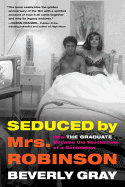
Was 1967's surprise hit The Graduate a middlebrow male fantasy or a shrewd comical exposé of a culture wrecked by materialism? Was it a purveyor of gratuitous "anti-adult sentiments" or a sympathetic salute to a generation whose parents had left them adrift? When the film--reductively, about a recent college graduate who has an affair with an older married woman--first appeared, not all critics were kind to it. But history has been, and rightly so, according to Beverly Gray's Seduced by Mrs. Robinson: How The Graduate Became the Touchstone of a Generation.
The analysis is split into three chunks, separated by relevant black-and-white photos and reproductions: a look at how The Graduate came to exist, an almost scene-by-scene dissection of the movie and an exploration of its enduring multigenerational appeal. Gray, a film industry veteran and the author of books on directors Ron Howard and Roger Corman, is an especially sharp chronicler of the movie's social context and influence. Among the aftereffects that she notes is what critic J. Hoberman called the "Jew Wave," or the sudden ubiquity of ethnic-looking male leads: before the risky casting of dark, protuberant-nosed, then-unknown Dustin Hoffman in The Graduate, leading men were supposed to look like Robert Redford.
In addition to supplying insights from the movie's key players and some non-marquee-name observers, Gray offers her own reflections, and their inclusion seems justified. As Gray, speaking for her generation, puts it, "The film had in some mysterious, intimate manner become a part of ourselves." --Nell Beram, freelance writer and author

